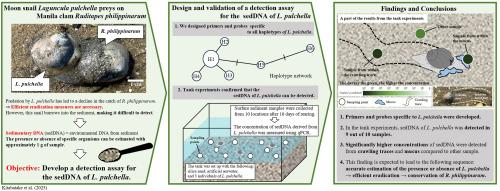以菲律宾马尼拉蛤为食的月牙蜗牛沉积DNA检测方法的建立
IF 2.6
3区 地球科学
Q1 MARINE & FRESHWATER BIOLOGY
引用次数: 0
摘要
原产于中国和朝鲜半岛的月螺(Laguncula pulchella)与进口的马尼拉蛤(Ruditapes philippinarum)一起入侵日本,并正在扩大其分布范围。本种优先以活的菲律宾沙蚕为食。最近,日本马尼拉蛤的全国产量明显下降。虽然这种下降的主要原因尚不清楚,但被L. pulchella捕食被认为是日本北部的一个促成因素。有效的根除措施对减轻捕食至关重要。然而,这种蜗牛经常钻入沉积物中,这使得探测具有挑战性,并且可能导致在之前的调查中低估其存在和分布。检测水和沉积物中存在的环境DNA的分析技术取得了进展。具体来说,沉积DNA (sedDNA)可以用来估计目标生物的分布,使用大约1g的沉积物。在这项研究中,我们的目的是利用sedDNA分析来估计L. pulchella的存在,并开发一种检测方法。在评估了该物种的分子系统发育后,我们设计了针对所有单倍型的引物和探针。此外,我们还进行了罐体实验,以证实可以检测到L. pulchella的sedDNA。检测到的最高浓度约为108拷贝/克,主要来自爬行痕迹。由于黏液保留在爬行痕迹中,它可能是sedDNA的主要来源。通过应用开发的检测方法,预计将有可能准确估计布氏乳杆菌的存在,从而导致有效的根除工作。本文章由计算机程序翻译,如有差异,请以英文原文为准。

Development of a sedimentary DNA detection assay for the invasive moon snail Laguncula pulchella preferentially preying on the Manila clam Ruditapes philippinarum
The moon snail Laguncula pulchella, native to China and the Korean Peninsula, has invaded Japan alongside the imported Manila clam Ruditapes philippinarum and is expanding its distribution. This species preferentially feeds on live R. philippinarum. Recently, the nationwide yield of Manila clams in Japan has declined significantly. Although the primary cause of this decline remains unclear, predation by L. pulchella is believed to be a contributing factor in northern Japan. Efficient eradication measures are essential to mitigate predation. However, this snail often burrows into sediment, making detection challenging and potentially leading to an underestimation of its presence and distribution in previous surveys. Analytical techniques for detecting environmental DNA present in water and sediment have advanced. Specifically, sedimentary DNA (sedDNA) can be used to estimate the distribution of target organisms using approximately 1 g of sediment. In this study, we aimed to estimate the presence of L. pulchella using sedDNA analysis, with the development of a detection assay. After evaluating the molecular phylogeny of this species, we designed primers and probes specific to all the haplotypes. Additionally, we performed tank experiments to confirm that the sedDNA of L. pulchella can be detected. The highest concentration detected was approximately 108 copies/g of sediment, mainly from crawling traces. Since mucus is retained in the crawling traces, it may serve as a primary source of sedDNA. By applying the developed detection assay, it is anticipated that accurate estimates of the presence of L. pulchella will be possible, leading to efficient eradication efforts.
求助全文
通过发布文献求助,成功后即可免费获取论文全文。
去求助
来源期刊
CiteScore
5.60
自引率
7.10%
发文量
374
审稿时长
9 months
期刊介绍:
Estuarine, Coastal and Shelf Science is an international multidisciplinary journal devoted to the analysis of saline water phenomena ranging from the outer edge of the continental shelf to the upper limits of the tidal zone. The journal provides a unique forum, unifying the multidisciplinary approaches to the study of the oceanography of estuaries, coastal zones, and continental shelf seas. It features original research papers, review papers and short communications treating such disciplines as zoology, botany, geology, sedimentology, physical oceanography.

 求助内容:
求助内容: 应助结果提醒方式:
应助结果提醒方式:


